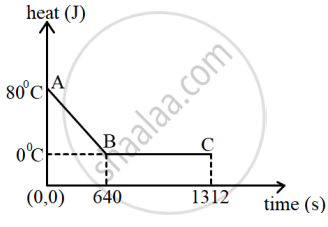Advertisements
Advertisements
प्रश्न
The diagram below shows a cooling curve for 200 g of water. The heat is extracted at the rate of 100 Js-1. Answer the questions that follow:

- Calculate specific heat capacity of water.
- Heat released in the region BC.
उत्तर
(a) mass of water (m) = 200 g = 0.2 kg.
Rate of heat extraction= 100 J/s.
So, total heat extracted for curve AB is = 100 × 640 = 64000 J
Now, for curve AB we can write,
64000 = 0.2 × Cp × (353 - 273) ...`[(80^circ "C" = 273 + 80 = 353;),(0^circ "C" = 273 + 0 = 273 "K")]`
Solving we get,
C = 4000 Jkg-1 K-1
Thus, the specific heat capacity of water is 4000 Jkg-1 K-1.
(b) From the figure it is clear that at point Band C is corresponds to time 640 sand 1312 s, respectively. Thus, heat released in region BC is = 100 × (1312 - 640) = 67,200 J
APPEARS IN
संबंधित प्रश्न
Why do the farmers fill their fields with water on a cold winter night?
The specific heat capacity of water is :
Give three reasons for the increase of green house gases.
What change in heat energy occurs when lead at its melting point
solidifies without change in the temperature?
650 J of heat is required to raise the temp. of 0.25 kg of lead from 15°C to 35°C. Calculate the Sp. heat capacity of lead.
State, with reason, which of the two, boiling water or steam both at 100°C will produce more severe burns.
Name the substance which has maximum specific heat capacity.
Consider the statement given below and choose the correct option.
Assertion: Radiation is a form of heat transfer which takes place only in vacuum.
Reason: The thermal energy is transferred from one part of a substance to another part without the actual movement of the atoms or molecules.
